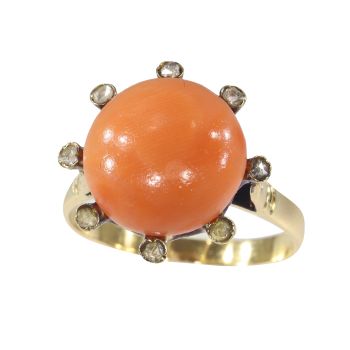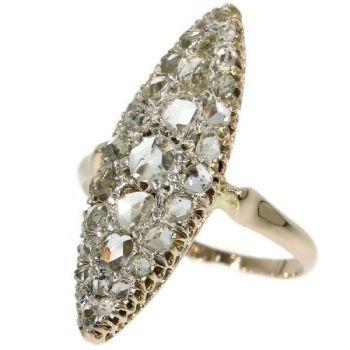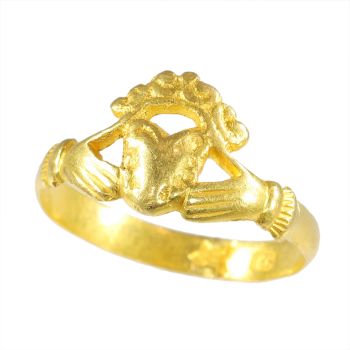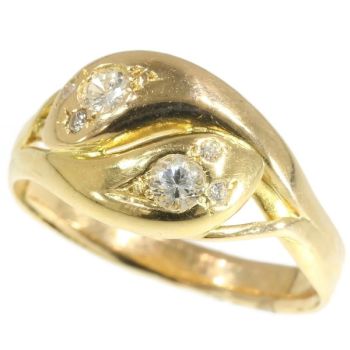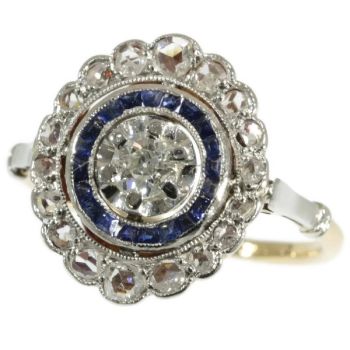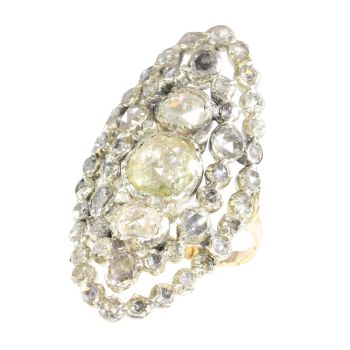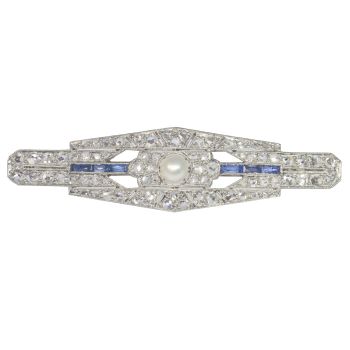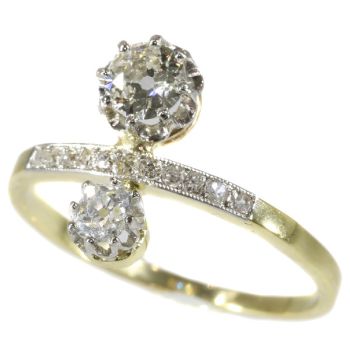Crowned Heart: An 18th-Century Rococo Diamond Ring of Rare Beauty 1730
Artista Desconhecido
Adin Fine Antique Jewellery
- Sobre arte
A masterpiece of early 18th-century Rococo elegance, this enchanting ring features a crowned heart motif, formed by a large, pear-shaped rose-cut diamond at its centre. Each diamond, set on foil-backed silver, shimmers with a lustre evocative of theera's opulence. Crafted in 14K pink gold, its intricate design reflects the ornate beauty and playful spirit of the Rococo period, a true testament to artistry. Bearing a Dutch hallmark, it invites admiration as a rare and exquisite symbol of love andloyalty, resonating deeply with the heritage of a bygone era.
Antique jewelry object group
ring
Condition
very good condition
more info on our condition scale
Country of origin
Although it bears no discernible control marks indicating its origin, there is a Dutch hallmark present, typically used for older items submitted for re-assessment. This does not guarantee it was actually made in the Netherlands. However, the 14K goldcontent could serve as an indicator, as this is a hallmark characteristic of Dutch craftsmanship, though it remains an uncertain attribution.
Style
Rococo - Rococo (less commonly roccoco) also referred to as "Late Baroque" is an 18th century style which developed as Baroque artists gave up their symmetry and became increasingly more ornate, florid, and playful. Rococo rooms were designed as totalworks of art with elegant and ornate furniture, small sculptures, ornamental mirrors, and tapestry complementing architecture, reliefs, and wall paintings. It was largely supplanted by the Neoclassic style. In 1835 the Dictionary of the French Academystated that the word Rococo "usually covers the kind of ornament, style and design associated with Louis XV's reign and the beginning of that of Louis XVI". It includes therefore, all types of art produced around the middle of the 18th century inFrance.
See also: Rococo
more info on styles
Style specifics
Rococo is a style of decoration that followed, c.1730, the baroque style in France (where it was also called rocaille), the principal features of which are asymmetry of ornament and a repertoire consisting to a considerable extent of rockwork, shells,flowers, foliage, and scrollwork. It was developed in France under Louis XV, 1715-74, and spread to Italy, Germany, and Austria and to a lesser extent to England.
Period
ca. 1730
Events & facts of this era, poetry of this era, fashion of this era.
Source of inspiration
Love and romance
Theme
A crowned heart - In jewellery, a crowned heart symbol often represents love, loyalty, and fidelity.
Material 14K
pink gold and details in silver (touchstone tested)
more info on precious metals
Technique
The rose cuts are set on foil. This is a special technique that was used to bring the lustre of the diamonds to its best quality.
Diamonds
Onelarge and seven smaller rose cut diamonds. We do not have the weight of the diamonds which is normal in our trade when it comes to rose cuts.
- All diamonds, regardless of their size or shape, in our vintage and antique jewellery are verified as 100% natural by the IJGC laboratory.
- We do not sell lab-grown (synthetic) diamonds.
Birthstones
Diamond is the birthstone (or month stone) for April.
more info on birthstones
Hallmarks
A Dutch hallmark representing the letter "i" (1852-1889) for articles that were already old or antique when given to be checked by the essay officed or antique when given to be checked by the essay office (used from 1852 till 1889).
more info on hallmarks
Dimensions
band width top of ring 1,42 cm (0,56 inch)
see picture with a ruler in millimeters and inches
Weight
2,30 gram (1,48 dwt)
Ring size Continental EU: 56 & 17¾ , Size USA: 7½ , Size UK: O½
Resizing
Free resizing (only for extreme resizing we have to charge).
more info on ring sizes
Adin Reference Nº
24246-0398
Copyright photography
Adin, fine antique jewellery
Additional information
our latest acquisitions
jewelry glossary
wall of fame
visit us in Antwerp
subscribe to our mailinglist
- Sobre artista
Pode acontecer que um artista ou criador seja desconhecido.
Algumas obras não devem ser determinadas por quem são feitas ou são feitas por (um grupo de) artesãos. Exemplos são estátuas dos tempos antigos, móveis, espelhos ou assinaturas que não são claras ou legíveis, mas também algumas obras não são assinadas.
Além disso, você pode encontrar a seguinte descrição:
•"Atribuído a …." Na opinião deles, provavelmente uma obra do artista, pelo menos em parte
• “Estúdio de…” ou “Oficina de” Em sua opinião um trabalho executado no estúdio ou oficina do artista, possivelmente sob sua supervisão
• "Círculo de ..." Na opinião deles, uma obra da época do artista mostrando sua influência, intimamente associada ao artista, mas não necessariamente seu aluno
•“Estilo de…” ou “Seguidor de…” Na opinião deles, um trabalho executado no estilo do artista, mas não necessariamente por um aluno; pode ser contemporâneo ou quase contemporâneo
• "Maneira de ..." Na opinião deles, uma obra no estilo do artista, mas de data posterior
•"Depois …." Na opinião deles uma cópia (de qualquer data) de uma obra do artista
• “Assinado…”, “Datado…” ou “Inscrito” Na opinião deles, a obra foi assinada/datada/inscrita pelo artista. A adição de um ponto de interrogação indica um elemento de dúvida
• "Com assinatura ….”, “Com data ….”, “Com inscrição ….” ou “Tem assinatura/data/inscrição” na opinião deles a assinatura/data/inscrição foi adicionada por outra pessoa que não o artista
Você está interessado em comprar esta obra de arte?
Related artworks
- 1 - 4 / 12
Onbekende Kunstenaar
A Surinam-themed Amsterdam long-case clock1746 - 1756
Prijs op aanvraagZebregs & Röell - Fine Art - Antiques
 Gecureerd door
Gecureerd doorGallerease Magazine
1 - 4 / 14- 1 - 4 / 24
- 1 - 4 / 24
- 1 - 4 / 12










